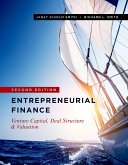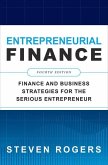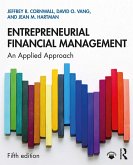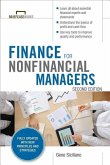Marco Da Rin (Associate Professor o Associate Professor of Finance, Thomas Hellmann (DP World Professor of Entrepreneurship and Innovat
Fundamentals of Entrepreneurial Finance
Marco Da Rin (Associate Professor o Associate Professor of Finance, Thomas Hellmann (DP World Professor of Entrepreneurship and Innovat
Fundamentals of Entrepreneurial Finance
- Gebundenes Buch
- Merkliste
- Auf die Merkliste
- Bewerten Bewerten
- Teilen
- Produkt teilen
- Produkterinnerung
- Produkterinnerung
Entrepreneurial finance brings together the fast-moving world of entrepreneurship with the disciplined world of finance. Fundamentals of Entrepreneurial Finance provides an accessible, yet rigorous, framework for understanding how ambitious, high-growth start-ups can successfully obtain funding and interact with investors.
Andere Kunden interessierten sich auch für
![Entrepreneurial Finance Entrepreneurial Finance]() Janet Kiholm SmithEntrepreneurial Finance125,99 €
Janet Kiholm SmithEntrepreneurial Finance125,99 €![Entrepreneurial Finance, Fourth Edition: Finance and Business Strategies for the Serious Entrepreneur Entrepreneurial Finance, Fourth Edition: Finance and Business Strategies for the Serious Entrepreneur]() Steven RogersEntrepreneurial Finance, Fourth Edition: Finance and Business Strategies for the Serious Entrepreneur86,99 €
Steven RogersEntrepreneurial Finance, Fourth Edition: Finance and Business Strategies for the Serious Entrepreneur86,99 €![Entrepreneurial Financial Management Entrepreneurial Financial Management]() Jeffrey R. CornwallEntrepreneurial Financial Management103,99 €
Jeffrey R. CornwallEntrepreneurial Financial Management103,99 €![Dream Bold, Start Smart Dream Bold, Start Smart]() Tatiana TsoirDream Bold, Start Smart22,99 €
Tatiana TsoirDream Bold, Start Smart22,99 €![From the Basement to the Dome: How Mits Unique Culture Created a Thriving Entrepreneurial Community From the Basement to the Dome: How Mits Unique Culture Created a Thriving Entrepreneurial Community]() Jean-Jacques DegroofFrom the Basement to the Dome: How Mits Unique Culture Created a Thriving Entrepreneurial Community27,99 €
Jean-Jacques DegroofFrom the Basement to the Dome: How Mits Unique Culture Created a Thriving Entrepreneurial Community27,99 €![Finance for Nonfinancial Managers, Second Edition (Briefcase Books Series) Finance for Nonfinancial Managers, Second Edition (Briefcase Books Series)]() Gene SicilianoFinance for Nonfinancial Managers, Second Edition (Briefcase Books Series)19,99 €
Gene SicilianoFinance for Nonfinancial Managers, Second Edition (Briefcase Books Series)19,99 €![The Candlestick Course The Candlestick Course]() Steve Nison (New York Institute of Finance)The Candlestick Course61,99 €
Steve Nison (New York Institute of Finance)The Candlestick Course61,99 €-
-
-
Entrepreneurial finance brings together the fast-moving world of entrepreneurship with the disciplined world of finance. Fundamentals of Entrepreneurial Finance provides an accessible, yet rigorous, framework for understanding how ambitious, high-growth start-ups can successfully obtain funding and interact with investors.
Hinweis: Dieser Artikel kann nur an eine deutsche Lieferadresse ausgeliefert werden.
Hinweis: Dieser Artikel kann nur an eine deutsche Lieferadresse ausgeliefert werden.
Produktdetails
- Produktdetails
- Verlag: Oxford University Press Inc
- Seitenzahl: 656
- Erscheinungstermin: 18. Februar 2020
- Englisch
- Abmessung: 263mm x 193mm x 55mm
- Gewicht: 1274g
- ISBN-13: 9780199744756
- ISBN-10: 0199744750
- Artikelnr.: 58502452
- Herstellerkennzeichnung
- Produktsicherheitsverantwortliche/r
- Europaallee 1
- 36244 Bad Hersfeld
- gpsr@libri.de
- Verlag: Oxford University Press Inc
- Seitenzahl: 656
- Erscheinungstermin: 18. Februar 2020
- Englisch
- Abmessung: 263mm x 193mm x 55mm
- Gewicht: 1274g
- ISBN-13: 9780199744756
- ISBN-10: 0199744750
- Artikelnr.: 58502452
- Herstellerkennzeichnung
- Produktsicherheitsverantwortliche/r
- Europaallee 1
- 36244 Bad Hersfeld
- gpsr@libri.de
Dr. Marco Da Rin is an Associate Professor of Finance at Tilburg University. He holds a PhD in Economics from Stanford University. He has designed and taught courses in entrepreneurship and entrepreneurial finance at the undergraduate, Master, doctoral, MBA, and executive level in several countries. His research and teaching focuses on entrepreneurial finance, entrepreneurship, venture capital and private equity, and public policy for entrepreneurship. He has also been a consultant to several international organizations, including the European Commission, the OECD, and the United Nations, as well as regional governments and private companies. He has advised and contributed to several start-ups. Dr. Thomas Hellmann is the DP World Professor of Entrepreneurship and Innovation at the Saïd School of Business, University of Oxford. He holds a PhD in Economics from Stanford University. His research and teaching interests cover entrepreneurial finance, entrepreneurship, innovation, strategic management, and public policy. He was previously on the faculty of the Stanford GSB and also taught at the Harvard Business School and Wharton. He is the founder of the NBER Entrepreneurship Research Boot Camp, the Academic Advisor of the Oxford Foundry, the Academic Director of SBS Entrepreneurship Centre, and Academic Lead of the Creative Destruction Lab - Oxford.
Chapter 1: Introduction to Entrepreneurial Finance
1.1 What is entrepreneurial finance?
1.2 Why is entrepreneurial finance challenging?
1.3 Why is entrepreneurial finance important?
1.4 Key facts about entrepreneurial finance
1.5 The entrepreneurial financing process
1.5.1 The need for frameworks
1.5.2 The FIRE framework
1.5.3 FIRE in practice
1.6 Who are the investors?
1.6.1 Main types of investors
1.6.2 The FUEL framework
Summary
Review questions
Chapter 2: Evaluating Venture Opportunities
2.1 Assessing Opportunities
2.1.1 The Venture Evaluation Matrix
2.1.2 The WorkHorse case study
2.2 Explaining the Venture Evaluation Matrix
2.2.1 Need
2.2.2 Solution
2.2.3 Team
2.2.4 Market
2.2.5 Competition
2.2.6 Network
2.2.7 Sales
2.2.8 Production
2.2.9 Organization
2.3 Drawing conclusions from the Venture Evaluation Matrix
2.3.1 Three perspectives on attractiveness
2.3.2 Three competitive advantages
2.3.3 Assessing risk
2.3.4 Interactions across cells
2.4 How entrepreneurs use the Venture Evaluation Matrix
2.4.1 The entrepreneur's decision
2.4.2 Writing a business plan
2.5 How investors use the Venture Evaluation Matrix
2.5.1 The Venture Evaluation Matrix spreadsheet tool
2.5.2 Investor due diligence
2.5.3 The investor's decision
Summary
Review questions
Chapter 3: The Financial Plan
3.1 The purpose of the financial plan
3.2 Financial projections
3.2.1 The three reflections
3.2.2 The structure of financial projections
3.2.3 Sources of information
3.2.4 Developing financial projections
3.3 Defining a timeline with milestones
3.4 Estimating revenues
3.4.1 The top-down approach
3.4.2 The bottom-up approach
3.4.3 Combining approaches
3.5 Estimating costs
3.5.1 Terminology
3.5.2 Costs of goods sold
3.5.3 Operating expenses
3.5.4 Capital expenditures
3.6 Pro forma financial statements
3.6.1 The structure of financial statements
3.6.2 Interpreting financial projections
3.6.3 Income versus cash flows
3.6.4 Testing financial projections
3.6.5 Simplifications
3.7 Formulating the financial plan
3.7.1 The attractiveness of the venture
3.7.2 Financing needs
3.7.3 Pitching the financial plan
Summary
Review questions
Chapter 4: Ownership and Returns
4.1 The mechanics of ownership and valuation
4.1.1 Pre-money and post-money valuation
4.1.2 Price and number of shares
4.1.3 Stock options
4.1.4 The capitalization table
4.1.5 Dilution with multiple rounds
4.2 Investor returns
4.2.1 Risk and return
4.2.2 Three measures of return
4.2.3 Comparing return measures
4.2.4 Returns with multiple rounds
4.3 The determinants of valuation and returns
4.3.1 The relationship between valuation and returns
4.3.2 The economic determinants of valuation
4.4 The determinants of founder ownership
4.4.1 Founder agreements
4.4.2 Principles for internal allocation
4.4.3 The FAST Tool
Summary
Review questions
Chapter 5: Valuation Methods
5.1 The valuation of entrepreneurial companies
5.1.1 The purpose of performing a valuation
5.1.2 The challenges of performing a valuation
5.2 The Venture Capital method
5.2.1 Valuation with a single investment round
5.2.2 Valuation with multiple investment rounds
5.2.3 Estimating the inputs
5.2.4 Model variants
5.3 The Discounted Cash Flow method
5.3.1 The mechanics of the DCF method
5.3.2 Estimating the inputs
5.4 Methods of Comparables
5.4.1 The Investment Comparables method
5.4.2 The Exit Comparables method
5.5 Modelling uncertainty
5.5.1 Scenario analysis and simulations
5.5.2 PROFEX
5.6 The choice of valuation model
Summary
Review questions
Chapter 6: Term Sheets
6.1 Term sheet fundamentals
6.1.1 The role of term sheets
6.1.2 Contingent contracting and milestones
6.1.3 Overview of terms
6.2 Cash flow rights
6.2.1 Convertible preferred stock
6.2.2 Participating preferred stock
6.2.3 Reasons for using preferred stock
6.3 Compensation
6.3.1 Founder employment agreements
6.3.2 Employee stock option plans
6.4 An overview of other terms
6.4.1 Control rights
6.4.2 Future fundraising
6.4.3 Investor liquidity
6.4.4 Additional clauses
6.5 Valuation versus terms
6.6 Convertible notes
6.6.1 How convertible notes work
6.6.2 Valuation caps
Summary
Review questions
Chapter 7: Structuring Deals
7.1 The art of structuring deals
7.2 The fundraising process
7.2.1 Preparing the fundraising campaign
7.2.2 Executing the fundraising campaign
7.2.3 Valuing an idea
7.3 Finding a match
7.3.1 Investor deal sourcing
7.3.2 Investor screening
7.3.3 The MATCH tool
7.4 Syndication
7.4.1 Reasons to syndicate
7.4.2 The structure of syndicates
7.5 Deal Negotiations
7.5.1 Bargaining theory
7.5.2 Negotiation analysis
7.5.3 Closing the deal
7.5.4 Deal negotiations with investor competition
7.6 Living with the deal
7.6.1 The importance of trust
7.6.2 A long-term perspective
Summary
Review questions
Chapter 8: Corporate Governance
8.1 The need for corporate governance
8.1.1 Why companies need investor involvement
8.1.2 Why investors oversee their companies
8.2 Corporate governance structures
8.2.1 Voting rights
8.2.2 Board of Directors
8.2.3 Informal control
8.3 Investor value-adding
8.3.1 Picking versus making winners
8.3.2 How investors add value
8.3.3 Where investors add value
8.3.4 The question of replacing managers
8.3.5 Assessing value-adding fit
Summary
Review questions
Chapter 9: Staged Financing
9.1 The rationale for staged financing
9.2 Structuring staged financing deals
9.2.1 Staged investments and ownership
9.2.2 The option value of staging
9.2.3 Tranching
9.2.4 Old versus new investors
9.3 Term sheets for staging
9.3.1 The liquidation stack
9.3.2 Anti-dilution rights
9.3.3 Additional rights
9.4 Managing financial difficulties
9.4.1 Down rounds
9.4.2 Turnarounds
9.5 Dynamic strategies
9.5.1 Dynamic investment strategies
9.5.2 Dynamic valuation profiles
Summary
Review questions
Chapter 10: Debt Financing
10.1 Fundamentals of debt
10.1.1 What is debt?
10.1.2 The structure of debt contracts
10.2 Debt versus equity
10.2.1 The fallacy that debt is cheaper than equity
10.2.2 Comparing debt and equity
10.3 Why banks don't lend to startups
10.4 Alternative types of debt
10.4.1 Personal loans and credit cards
10.4.2 Trade credit
10.4.3 Discounting and factoring
10.4.4 Venture leasing
10.4.5 Venture debt
10.5 Valuation with debt
10.5.1 Enterprise versus equity value
10.5.2 Adjusting valuation methods for debt
Summary
Review questions
Chapter 11: Exit
11.1 The importance of exiting investments
11.1.1 Reasons for exit
11.1.2 The four main types of exit
11.1.3 The exit decision
11.1.4 The timing of exit
11.2 Initial Public Offerings
11.2.1 Benefits and costs
11.2.2 Preparing for an IPO
11.2.3 Pricing the IPO
11.2.4 Structuring the IPO
11.2.5 After the IPO
11.3 Acquisitions
11.3.1 Strategic motives
11.3.2 Preparing for an acquisition
11.3.3 Structuring an acquisition
11.3.4 After the acquisition
11.4 Sale to financial buyers
11.4.1 Buyouts
11.4.2 Secondary sales
11.5 Closing down the company
11.6 Determinants of the exit decision
11.6.1 Market forces
11.6.2 Economic fundamentals
11.6.3 Internal company dynamics
Summary
Review questions
Chapter 12: Venture Capital
12.1 The venture capital model
12.2 Institutional investors (LPs)
12.2.1 Portfolio allocation choices
12.2.2 Building a VC portfolio
12.3 Limited Partnership Agreements
12.3.1 Fund structure
12.3.2 Fund rules
12.3.3 GP compensation
12.3.4 GP incentives
12.4 VC firms (GPs)
12.4.1 Internal structure
12.4.2 Fundraising
12.4.3 Networks
12.4.4 Alternatives to the partnership model
12.5 Investment strategies
12.5.1 The investment strategy
12.5.2 Investment strategy styles
12.5.3 Implementing the investment strategy
12.5.4 An example
12.6 Risk and return in VC
12.6.1 Gross returns to the VC fund
12.6.2 Net returns to limited partners
12.6.3 Assessing VC fund performance
Summary
Chapter 13: Early-Stage Investors
13.1 Founders, family, and friends
13.1.1 Reasons for investing
13.1.2 How family and friends invest
13.2 Angel investors
13.2.1 Different types of angel investors
13.2.2 How angels invest
13.3 Corporate investors
13.3.1 The motivation of corporate investors
13.3.2 The structure of corporate investors
13.3.3 How corporates invest
13.4 Crowdfunding
13.4.1 The structure of crowdfunding platforms
13.4.2 Motivations in crowdfunding
13.4.3 Crowdfunding campaigns
13.4.4 Returns from crowdfunding
13.5 Initial Coin Offerings
13.5.1 The Blockchain and cryptocurrencies
13.5.2 The structure of Initial Coin Offerings
13.5.3 The current debate about Initial Coin Offerings
13.6 Further investor types
13.6.1 Accelerators and incubators
13.6.2 Technology transfer funds
13.6.3 Social impact venture investors
13.7 Comparing early stage investors
Summary
Review questions
Chapter 14: Ecosystems
14.1 Entrepreneurial ecosystems
14.1.1 Ecosystem structure
14.1.2 Overview of leading ecosystems
14.2 How do entrepreneurial ecosystem work?
14.2.1 Interactions within the talent pool
14.2.2 Interactions with investors
14.2.3 Interactions with supporting parties
14.3 The role of government
14.3.1 Should the government support entrepreneurial ecosystems?
14.3.2 Government funding
14.3.3 Tax credits
14.3.4 Capital markets
14.3.5 Framework conditions
14.3.6 Demand side policies
14.4 Global ecosystems
14.4.1 The global movement of capital
14.4.2 The global movement of talent
Summary
Review questions
Bibliography
Index
1.1 What is entrepreneurial finance?
1.2 Why is entrepreneurial finance challenging?
1.3 Why is entrepreneurial finance important?
1.4 Key facts about entrepreneurial finance
1.5 The entrepreneurial financing process
1.5.1 The need for frameworks
1.5.2 The FIRE framework
1.5.3 FIRE in practice
1.6 Who are the investors?
1.6.1 Main types of investors
1.6.2 The FUEL framework
Summary
Review questions
Chapter 2: Evaluating Venture Opportunities
2.1 Assessing Opportunities
2.1.1 The Venture Evaluation Matrix
2.1.2 The WorkHorse case study
2.2 Explaining the Venture Evaluation Matrix
2.2.1 Need
2.2.2 Solution
2.2.3 Team
2.2.4 Market
2.2.5 Competition
2.2.6 Network
2.2.7 Sales
2.2.8 Production
2.2.9 Organization
2.3 Drawing conclusions from the Venture Evaluation Matrix
2.3.1 Three perspectives on attractiveness
2.3.2 Three competitive advantages
2.3.3 Assessing risk
2.3.4 Interactions across cells
2.4 How entrepreneurs use the Venture Evaluation Matrix
2.4.1 The entrepreneur's decision
2.4.2 Writing a business plan
2.5 How investors use the Venture Evaluation Matrix
2.5.1 The Venture Evaluation Matrix spreadsheet tool
2.5.2 Investor due diligence
2.5.3 The investor's decision
Summary
Review questions
Chapter 3: The Financial Plan
3.1 The purpose of the financial plan
3.2 Financial projections
3.2.1 The three reflections
3.2.2 The structure of financial projections
3.2.3 Sources of information
3.2.4 Developing financial projections
3.3 Defining a timeline with milestones
3.4 Estimating revenues
3.4.1 The top-down approach
3.4.2 The bottom-up approach
3.4.3 Combining approaches
3.5 Estimating costs
3.5.1 Terminology
3.5.2 Costs of goods sold
3.5.3 Operating expenses
3.5.4 Capital expenditures
3.6 Pro forma financial statements
3.6.1 The structure of financial statements
3.6.2 Interpreting financial projections
3.6.3 Income versus cash flows
3.6.4 Testing financial projections
3.6.5 Simplifications
3.7 Formulating the financial plan
3.7.1 The attractiveness of the venture
3.7.2 Financing needs
3.7.3 Pitching the financial plan
Summary
Review questions
Chapter 4: Ownership and Returns
4.1 The mechanics of ownership and valuation
4.1.1 Pre-money and post-money valuation
4.1.2 Price and number of shares
4.1.3 Stock options
4.1.4 The capitalization table
4.1.5 Dilution with multiple rounds
4.2 Investor returns
4.2.1 Risk and return
4.2.2 Three measures of return
4.2.3 Comparing return measures
4.2.4 Returns with multiple rounds
4.3 The determinants of valuation and returns
4.3.1 The relationship between valuation and returns
4.3.2 The economic determinants of valuation
4.4 The determinants of founder ownership
4.4.1 Founder agreements
4.4.2 Principles for internal allocation
4.4.3 The FAST Tool
Summary
Review questions
Chapter 5: Valuation Methods
5.1 The valuation of entrepreneurial companies
5.1.1 The purpose of performing a valuation
5.1.2 The challenges of performing a valuation
5.2 The Venture Capital method
5.2.1 Valuation with a single investment round
5.2.2 Valuation with multiple investment rounds
5.2.3 Estimating the inputs
5.2.4 Model variants
5.3 The Discounted Cash Flow method
5.3.1 The mechanics of the DCF method
5.3.2 Estimating the inputs
5.4 Methods of Comparables
5.4.1 The Investment Comparables method
5.4.2 The Exit Comparables method
5.5 Modelling uncertainty
5.5.1 Scenario analysis and simulations
5.5.2 PROFEX
5.6 The choice of valuation model
Summary
Review questions
Chapter 6: Term Sheets
6.1 Term sheet fundamentals
6.1.1 The role of term sheets
6.1.2 Contingent contracting and milestones
6.1.3 Overview of terms
6.2 Cash flow rights
6.2.1 Convertible preferred stock
6.2.2 Participating preferred stock
6.2.3 Reasons for using preferred stock
6.3 Compensation
6.3.1 Founder employment agreements
6.3.2 Employee stock option plans
6.4 An overview of other terms
6.4.1 Control rights
6.4.2 Future fundraising
6.4.3 Investor liquidity
6.4.4 Additional clauses
6.5 Valuation versus terms
6.6 Convertible notes
6.6.1 How convertible notes work
6.6.2 Valuation caps
Summary
Review questions
Chapter 7: Structuring Deals
7.1 The art of structuring deals
7.2 The fundraising process
7.2.1 Preparing the fundraising campaign
7.2.2 Executing the fundraising campaign
7.2.3 Valuing an idea
7.3 Finding a match
7.3.1 Investor deal sourcing
7.3.2 Investor screening
7.3.3 The MATCH tool
7.4 Syndication
7.4.1 Reasons to syndicate
7.4.2 The structure of syndicates
7.5 Deal Negotiations
7.5.1 Bargaining theory
7.5.2 Negotiation analysis
7.5.3 Closing the deal
7.5.4 Deal negotiations with investor competition
7.6 Living with the deal
7.6.1 The importance of trust
7.6.2 A long-term perspective
Summary
Review questions
Chapter 8: Corporate Governance
8.1 The need for corporate governance
8.1.1 Why companies need investor involvement
8.1.2 Why investors oversee their companies
8.2 Corporate governance structures
8.2.1 Voting rights
8.2.2 Board of Directors
8.2.3 Informal control
8.3 Investor value-adding
8.3.1 Picking versus making winners
8.3.2 How investors add value
8.3.3 Where investors add value
8.3.4 The question of replacing managers
8.3.5 Assessing value-adding fit
Summary
Review questions
Chapter 9: Staged Financing
9.1 The rationale for staged financing
9.2 Structuring staged financing deals
9.2.1 Staged investments and ownership
9.2.2 The option value of staging
9.2.3 Tranching
9.2.4 Old versus new investors
9.3 Term sheets for staging
9.3.1 The liquidation stack
9.3.2 Anti-dilution rights
9.3.3 Additional rights
9.4 Managing financial difficulties
9.4.1 Down rounds
9.4.2 Turnarounds
9.5 Dynamic strategies
9.5.1 Dynamic investment strategies
9.5.2 Dynamic valuation profiles
Summary
Review questions
Chapter 10: Debt Financing
10.1 Fundamentals of debt
10.1.1 What is debt?
10.1.2 The structure of debt contracts
10.2 Debt versus equity
10.2.1 The fallacy that debt is cheaper than equity
10.2.2 Comparing debt and equity
10.3 Why banks don't lend to startups
10.4 Alternative types of debt
10.4.1 Personal loans and credit cards
10.4.2 Trade credit
10.4.3 Discounting and factoring
10.4.4 Venture leasing
10.4.5 Venture debt
10.5 Valuation with debt
10.5.1 Enterprise versus equity value
10.5.2 Adjusting valuation methods for debt
Summary
Review questions
Chapter 11: Exit
11.1 The importance of exiting investments
11.1.1 Reasons for exit
11.1.2 The four main types of exit
11.1.3 The exit decision
11.1.4 The timing of exit
11.2 Initial Public Offerings
11.2.1 Benefits and costs
11.2.2 Preparing for an IPO
11.2.3 Pricing the IPO
11.2.4 Structuring the IPO
11.2.5 After the IPO
11.3 Acquisitions
11.3.1 Strategic motives
11.3.2 Preparing for an acquisition
11.3.3 Structuring an acquisition
11.3.4 After the acquisition
11.4 Sale to financial buyers
11.4.1 Buyouts
11.4.2 Secondary sales
11.5 Closing down the company
11.6 Determinants of the exit decision
11.6.1 Market forces
11.6.2 Economic fundamentals
11.6.3 Internal company dynamics
Summary
Review questions
Chapter 12: Venture Capital
12.1 The venture capital model
12.2 Institutional investors (LPs)
12.2.1 Portfolio allocation choices
12.2.2 Building a VC portfolio
12.3 Limited Partnership Agreements
12.3.1 Fund structure
12.3.2 Fund rules
12.3.3 GP compensation
12.3.4 GP incentives
12.4 VC firms (GPs)
12.4.1 Internal structure
12.4.2 Fundraising
12.4.3 Networks
12.4.4 Alternatives to the partnership model
12.5 Investment strategies
12.5.1 The investment strategy
12.5.2 Investment strategy styles
12.5.3 Implementing the investment strategy
12.5.4 An example
12.6 Risk and return in VC
12.6.1 Gross returns to the VC fund
12.6.2 Net returns to limited partners
12.6.3 Assessing VC fund performance
Summary
Chapter 13: Early-Stage Investors
13.1 Founders, family, and friends
13.1.1 Reasons for investing
13.1.2 How family and friends invest
13.2 Angel investors
13.2.1 Different types of angel investors
13.2.2 How angels invest
13.3 Corporate investors
13.3.1 The motivation of corporate investors
13.3.2 The structure of corporate investors
13.3.3 How corporates invest
13.4 Crowdfunding
13.4.1 The structure of crowdfunding platforms
13.4.2 Motivations in crowdfunding
13.4.3 Crowdfunding campaigns
13.4.4 Returns from crowdfunding
13.5 Initial Coin Offerings
13.5.1 The Blockchain and cryptocurrencies
13.5.2 The structure of Initial Coin Offerings
13.5.3 The current debate about Initial Coin Offerings
13.6 Further investor types
13.6.1 Accelerators and incubators
13.6.2 Technology transfer funds
13.6.3 Social impact venture investors
13.7 Comparing early stage investors
Summary
Review questions
Chapter 14: Ecosystems
14.1 Entrepreneurial ecosystems
14.1.1 Ecosystem structure
14.1.2 Overview of leading ecosystems
14.2 How do entrepreneurial ecosystem work?
14.2.1 Interactions within the talent pool
14.2.2 Interactions with investors
14.2.3 Interactions with supporting parties
14.3 The role of government
14.3.1 Should the government support entrepreneurial ecosystems?
14.3.2 Government funding
14.3.3 Tax credits
14.3.4 Capital markets
14.3.5 Framework conditions
14.3.6 Demand side policies
14.4 Global ecosystems
14.4.1 The global movement of capital
14.4.2 The global movement of talent
Summary
Review questions
Bibliography
Index
Chapter 1: Introduction to Entrepreneurial Finance
1.1 What is entrepreneurial finance?
1.2 Why is entrepreneurial finance challenging?
1.3 Why is entrepreneurial finance important?
1.4 Key facts about entrepreneurial finance
1.5 The entrepreneurial financing process
1.5.1 The need for frameworks
1.5.2 The FIRE framework
1.5.3 FIRE in practice
1.6 Who are the investors?
1.6.1 Main types of investors
1.6.2 The FUEL framework
Summary
Review questions
Chapter 2: Evaluating Venture Opportunities
2.1 Assessing Opportunities
2.1.1 The Venture Evaluation Matrix
2.1.2 The WorkHorse case study
2.2 Explaining the Venture Evaluation Matrix
2.2.1 Need
2.2.2 Solution
2.2.3 Team
2.2.4 Market
2.2.5 Competition
2.2.6 Network
2.2.7 Sales
2.2.8 Production
2.2.9 Organization
2.3 Drawing conclusions from the Venture Evaluation Matrix
2.3.1 Three perspectives on attractiveness
2.3.2 Three competitive advantages
2.3.3 Assessing risk
2.3.4 Interactions across cells
2.4 How entrepreneurs use the Venture Evaluation Matrix
2.4.1 The entrepreneur's decision
2.4.2 Writing a business plan
2.5 How investors use the Venture Evaluation Matrix
2.5.1 The Venture Evaluation Matrix spreadsheet tool
2.5.2 Investor due diligence
2.5.3 The investor's decision
Summary
Review questions
Chapter 3: The Financial Plan
3.1 The purpose of the financial plan
3.2 Financial projections
3.2.1 The three reflections
3.2.2 The structure of financial projections
3.2.3 Sources of information
3.2.4 Developing financial projections
3.3 Defining a timeline with milestones
3.4 Estimating revenues
3.4.1 The top-down approach
3.4.2 The bottom-up approach
3.4.3 Combining approaches
3.5 Estimating costs
3.5.1 Terminology
3.5.2 Costs of goods sold
3.5.3 Operating expenses
3.5.4 Capital expenditures
3.6 Pro forma financial statements
3.6.1 The structure of financial statements
3.6.2 Interpreting financial projections
3.6.3 Income versus cash flows
3.6.4 Testing financial projections
3.6.5 Simplifications
3.7 Formulating the financial plan
3.7.1 The attractiveness of the venture
3.7.2 Financing needs
3.7.3 Pitching the financial plan
Summary
Review questions
Chapter 4: Ownership and Returns
4.1 The mechanics of ownership and valuation
4.1.1 Pre-money and post-money valuation
4.1.2 Price and number of shares
4.1.3 Stock options
4.1.4 The capitalization table
4.1.5 Dilution with multiple rounds
4.2 Investor returns
4.2.1 Risk and return
4.2.2 Three measures of return
4.2.3 Comparing return measures
4.2.4 Returns with multiple rounds
4.3 The determinants of valuation and returns
4.3.1 The relationship between valuation and returns
4.3.2 The economic determinants of valuation
4.4 The determinants of founder ownership
4.4.1 Founder agreements
4.4.2 Principles for internal allocation
4.4.3 The FAST Tool
Summary
Review questions
Chapter 5: Valuation Methods
5.1 The valuation of entrepreneurial companies
5.1.1 The purpose of performing a valuation
5.1.2 The challenges of performing a valuation
5.2 The Venture Capital method
5.2.1 Valuation with a single investment round
5.2.2 Valuation with multiple investment rounds
5.2.3 Estimating the inputs
5.2.4 Model variants
5.3 The Discounted Cash Flow method
5.3.1 The mechanics of the DCF method
5.3.2 Estimating the inputs
5.4 Methods of Comparables
5.4.1 The Investment Comparables method
5.4.2 The Exit Comparables method
5.5 Modelling uncertainty
5.5.1 Scenario analysis and simulations
5.5.2 PROFEX
5.6 The choice of valuation model
Summary
Review questions
Chapter 6: Term Sheets
6.1 Term sheet fundamentals
6.1.1 The role of term sheets
6.1.2 Contingent contracting and milestones
6.1.3 Overview of terms
6.2 Cash flow rights
6.2.1 Convertible preferred stock
6.2.2 Participating preferred stock
6.2.3 Reasons for using preferred stock
6.3 Compensation
6.3.1 Founder employment agreements
6.3.2 Employee stock option plans
6.4 An overview of other terms
6.4.1 Control rights
6.4.2 Future fundraising
6.4.3 Investor liquidity
6.4.4 Additional clauses
6.5 Valuation versus terms
6.6 Convertible notes
6.6.1 How convertible notes work
6.6.2 Valuation caps
Summary
Review questions
Chapter 7: Structuring Deals
7.1 The art of structuring deals
7.2 The fundraising process
7.2.1 Preparing the fundraising campaign
7.2.2 Executing the fundraising campaign
7.2.3 Valuing an idea
7.3 Finding a match
7.3.1 Investor deal sourcing
7.3.2 Investor screening
7.3.3 The MATCH tool
7.4 Syndication
7.4.1 Reasons to syndicate
7.4.2 The structure of syndicates
7.5 Deal Negotiations
7.5.1 Bargaining theory
7.5.2 Negotiation analysis
7.5.3 Closing the deal
7.5.4 Deal negotiations with investor competition
7.6 Living with the deal
7.6.1 The importance of trust
7.6.2 A long-term perspective
Summary
Review questions
Chapter 8: Corporate Governance
8.1 The need for corporate governance
8.1.1 Why companies need investor involvement
8.1.2 Why investors oversee their companies
8.2 Corporate governance structures
8.2.1 Voting rights
8.2.2 Board of Directors
8.2.3 Informal control
8.3 Investor value-adding
8.3.1 Picking versus making winners
8.3.2 How investors add value
8.3.3 Where investors add value
8.3.4 The question of replacing managers
8.3.5 Assessing value-adding fit
Summary
Review questions
Chapter 9: Staged Financing
9.1 The rationale for staged financing
9.2 Structuring staged financing deals
9.2.1 Staged investments and ownership
9.2.2 The option value of staging
9.2.3 Tranching
9.2.4 Old versus new investors
9.3 Term sheets for staging
9.3.1 The liquidation stack
9.3.2 Anti-dilution rights
9.3.3 Additional rights
9.4 Managing financial difficulties
9.4.1 Down rounds
9.4.2 Turnarounds
9.5 Dynamic strategies
9.5.1 Dynamic investment strategies
9.5.2 Dynamic valuation profiles
Summary
Review questions
Chapter 10: Debt Financing
10.1 Fundamentals of debt
10.1.1 What is debt?
10.1.2 The structure of debt contracts
10.2 Debt versus equity
10.2.1 The fallacy that debt is cheaper than equity
10.2.2 Comparing debt and equity
10.3 Why banks don't lend to startups
10.4 Alternative types of debt
10.4.1 Personal loans and credit cards
10.4.2 Trade credit
10.4.3 Discounting and factoring
10.4.4 Venture leasing
10.4.5 Venture debt
10.5 Valuation with debt
10.5.1 Enterprise versus equity value
10.5.2 Adjusting valuation methods for debt
Summary
Review questions
Chapter 11: Exit
11.1 The importance of exiting investments
11.1.1 Reasons for exit
11.1.2 The four main types of exit
11.1.3 The exit decision
11.1.4 The timing of exit
11.2 Initial Public Offerings
11.2.1 Benefits and costs
11.2.2 Preparing for an IPO
11.2.3 Pricing the IPO
11.2.4 Structuring the IPO
11.2.5 After the IPO
11.3 Acquisitions
11.3.1 Strategic motives
11.3.2 Preparing for an acquisition
11.3.3 Structuring an acquisition
11.3.4 After the acquisition
11.4 Sale to financial buyers
11.4.1 Buyouts
11.4.2 Secondary sales
11.5 Closing down the company
11.6 Determinants of the exit decision
11.6.1 Market forces
11.6.2 Economic fundamentals
11.6.3 Internal company dynamics
Summary
Review questions
Chapter 12: Venture Capital
12.1 The venture capital model
12.2 Institutional investors (LPs)
12.2.1 Portfolio allocation choices
12.2.2 Building a VC portfolio
12.3 Limited Partnership Agreements
12.3.1 Fund structure
12.3.2 Fund rules
12.3.3 GP compensation
12.3.4 GP incentives
12.4 VC firms (GPs)
12.4.1 Internal structure
12.4.2 Fundraising
12.4.3 Networks
12.4.4 Alternatives to the partnership model
12.5 Investment strategies
12.5.1 The investment strategy
12.5.2 Investment strategy styles
12.5.3 Implementing the investment strategy
12.5.4 An example
12.6 Risk and return in VC
12.6.1 Gross returns to the VC fund
12.6.2 Net returns to limited partners
12.6.3 Assessing VC fund performance
Summary
Chapter 13: Early-Stage Investors
13.1 Founders, family, and friends
13.1.1 Reasons for investing
13.1.2 How family and friends invest
13.2 Angel investors
13.2.1 Different types of angel investors
13.2.2 How angels invest
13.3 Corporate investors
13.3.1 The motivation of corporate investors
13.3.2 The structure of corporate investors
13.3.3 How corporates invest
13.4 Crowdfunding
13.4.1 The structure of crowdfunding platforms
13.4.2 Motivations in crowdfunding
13.4.3 Crowdfunding campaigns
13.4.4 Returns from crowdfunding
13.5 Initial Coin Offerings
13.5.1 The Blockchain and cryptocurrencies
13.5.2 The structure of Initial Coin Offerings
13.5.3 The current debate about Initial Coin Offerings
13.6 Further investor types
13.6.1 Accelerators and incubators
13.6.2 Technology transfer funds
13.6.3 Social impact venture investors
13.7 Comparing early stage investors
Summary
Review questions
Chapter 14: Ecosystems
14.1 Entrepreneurial ecosystems
14.1.1 Ecosystem structure
14.1.2 Overview of leading ecosystems
14.2 How do entrepreneurial ecosystem work?
14.2.1 Interactions within the talent pool
14.2.2 Interactions with investors
14.2.3 Interactions with supporting parties
14.3 The role of government
14.3.1 Should the government support entrepreneurial ecosystems?
14.3.2 Government funding
14.3.3 Tax credits
14.3.4 Capital markets
14.3.5 Framework conditions
14.3.6 Demand side policies
14.4 Global ecosystems
14.4.1 The global movement of capital
14.4.2 The global movement of talent
Summary
Review questions
Bibliography
Index
1.1 What is entrepreneurial finance?
1.2 Why is entrepreneurial finance challenging?
1.3 Why is entrepreneurial finance important?
1.4 Key facts about entrepreneurial finance
1.5 The entrepreneurial financing process
1.5.1 The need for frameworks
1.5.2 The FIRE framework
1.5.3 FIRE in practice
1.6 Who are the investors?
1.6.1 Main types of investors
1.6.2 The FUEL framework
Summary
Review questions
Chapter 2: Evaluating Venture Opportunities
2.1 Assessing Opportunities
2.1.1 The Venture Evaluation Matrix
2.1.2 The WorkHorse case study
2.2 Explaining the Venture Evaluation Matrix
2.2.1 Need
2.2.2 Solution
2.2.3 Team
2.2.4 Market
2.2.5 Competition
2.2.6 Network
2.2.7 Sales
2.2.8 Production
2.2.9 Organization
2.3 Drawing conclusions from the Venture Evaluation Matrix
2.3.1 Three perspectives on attractiveness
2.3.2 Three competitive advantages
2.3.3 Assessing risk
2.3.4 Interactions across cells
2.4 How entrepreneurs use the Venture Evaluation Matrix
2.4.1 The entrepreneur's decision
2.4.2 Writing a business plan
2.5 How investors use the Venture Evaluation Matrix
2.5.1 The Venture Evaluation Matrix spreadsheet tool
2.5.2 Investor due diligence
2.5.3 The investor's decision
Summary
Review questions
Chapter 3: The Financial Plan
3.1 The purpose of the financial plan
3.2 Financial projections
3.2.1 The three reflections
3.2.2 The structure of financial projections
3.2.3 Sources of information
3.2.4 Developing financial projections
3.3 Defining a timeline with milestones
3.4 Estimating revenues
3.4.1 The top-down approach
3.4.2 The bottom-up approach
3.4.3 Combining approaches
3.5 Estimating costs
3.5.1 Terminology
3.5.2 Costs of goods sold
3.5.3 Operating expenses
3.5.4 Capital expenditures
3.6 Pro forma financial statements
3.6.1 The structure of financial statements
3.6.2 Interpreting financial projections
3.6.3 Income versus cash flows
3.6.4 Testing financial projections
3.6.5 Simplifications
3.7 Formulating the financial plan
3.7.1 The attractiveness of the venture
3.7.2 Financing needs
3.7.3 Pitching the financial plan
Summary
Review questions
Chapter 4: Ownership and Returns
4.1 The mechanics of ownership and valuation
4.1.1 Pre-money and post-money valuation
4.1.2 Price and number of shares
4.1.3 Stock options
4.1.4 The capitalization table
4.1.5 Dilution with multiple rounds
4.2 Investor returns
4.2.1 Risk and return
4.2.2 Three measures of return
4.2.3 Comparing return measures
4.2.4 Returns with multiple rounds
4.3 The determinants of valuation and returns
4.3.1 The relationship between valuation and returns
4.3.2 The economic determinants of valuation
4.4 The determinants of founder ownership
4.4.1 Founder agreements
4.4.2 Principles for internal allocation
4.4.3 The FAST Tool
Summary
Review questions
Chapter 5: Valuation Methods
5.1 The valuation of entrepreneurial companies
5.1.1 The purpose of performing a valuation
5.1.2 The challenges of performing a valuation
5.2 The Venture Capital method
5.2.1 Valuation with a single investment round
5.2.2 Valuation with multiple investment rounds
5.2.3 Estimating the inputs
5.2.4 Model variants
5.3 The Discounted Cash Flow method
5.3.1 The mechanics of the DCF method
5.3.2 Estimating the inputs
5.4 Methods of Comparables
5.4.1 The Investment Comparables method
5.4.2 The Exit Comparables method
5.5 Modelling uncertainty
5.5.1 Scenario analysis and simulations
5.5.2 PROFEX
5.6 The choice of valuation model
Summary
Review questions
Chapter 6: Term Sheets
6.1 Term sheet fundamentals
6.1.1 The role of term sheets
6.1.2 Contingent contracting and milestones
6.1.3 Overview of terms
6.2 Cash flow rights
6.2.1 Convertible preferred stock
6.2.2 Participating preferred stock
6.2.3 Reasons for using preferred stock
6.3 Compensation
6.3.1 Founder employment agreements
6.3.2 Employee stock option plans
6.4 An overview of other terms
6.4.1 Control rights
6.4.2 Future fundraising
6.4.3 Investor liquidity
6.4.4 Additional clauses
6.5 Valuation versus terms
6.6 Convertible notes
6.6.1 How convertible notes work
6.6.2 Valuation caps
Summary
Review questions
Chapter 7: Structuring Deals
7.1 The art of structuring deals
7.2 The fundraising process
7.2.1 Preparing the fundraising campaign
7.2.2 Executing the fundraising campaign
7.2.3 Valuing an idea
7.3 Finding a match
7.3.1 Investor deal sourcing
7.3.2 Investor screening
7.3.3 The MATCH tool
7.4 Syndication
7.4.1 Reasons to syndicate
7.4.2 The structure of syndicates
7.5 Deal Negotiations
7.5.1 Bargaining theory
7.5.2 Negotiation analysis
7.5.3 Closing the deal
7.5.4 Deal negotiations with investor competition
7.6 Living with the deal
7.6.1 The importance of trust
7.6.2 A long-term perspective
Summary
Review questions
Chapter 8: Corporate Governance
8.1 The need for corporate governance
8.1.1 Why companies need investor involvement
8.1.2 Why investors oversee their companies
8.2 Corporate governance structures
8.2.1 Voting rights
8.2.2 Board of Directors
8.2.3 Informal control
8.3 Investor value-adding
8.3.1 Picking versus making winners
8.3.2 How investors add value
8.3.3 Where investors add value
8.3.4 The question of replacing managers
8.3.5 Assessing value-adding fit
Summary
Review questions
Chapter 9: Staged Financing
9.1 The rationale for staged financing
9.2 Structuring staged financing deals
9.2.1 Staged investments and ownership
9.2.2 The option value of staging
9.2.3 Tranching
9.2.4 Old versus new investors
9.3 Term sheets for staging
9.3.1 The liquidation stack
9.3.2 Anti-dilution rights
9.3.3 Additional rights
9.4 Managing financial difficulties
9.4.1 Down rounds
9.4.2 Turnarounds
9.5 Dynamic strategies
9.5.1 Dynamic investment strategies
9.5.2 Dynamic valuation profiles
Summary
Review questions
Chapter 10: Debt Financing
10.1 Fundamentals of debt
10.1.1 What is debt?
10.1.2 The structure of debt contracts
10.2 Debt versus equity
10.2.1 The fallacy that debt is cheaper than equity
10.2.2 Comparing debt and equity
10.3 Why banks don't lend to startups
10.4 Alternative types of debt
10.4.1 Personal loans and credit cards
10.4.2 Trade credit
10.4.3 Discounting and factoring
10.4.4 Venture leasing
10.4.5 Venture debt
10.5 Valuation with debt
10.5.1 Enterprise versus equity value
10.5.2 Adjusting valuation methods for debt
Summary
Review questions
Chapter 11: Exit
11.1 The importance of exiting investments
11.1.1 Reasons for exit
11.1.2 The four main types of exit
11.1.3 The exit decision
11.1.4 The timing of exit
11.2 Initial Public Offerings
11.2.1 Benefits and costs
11.2.2 Preparing for an IPO
11.2.3 Pricing the IPO
11.2.4 Structuring the IPO
11.2.5 After the IPO
11.3 Acquisitions
11.3.1 Strategic motives
11.3.2 Preparing for an acquisition
11.3.3 Structuring an acquisition
11.3.4 After the acquisition
11.4 Sale to financial buyers
11.4.1 Buyouts
11.4.2 Secondary sales
11.5 Closing down the company
11.6 Determinants of the exit decision
11.6.1 Market forces
11.6.2 Economic fundamentals
11.6.3 Internal company dynamics
Summary
Review questions
Chapter 12: Venture Capital
12.1 The venture capital model
12.2 Institutional investors (LPs)
12.2.1 Portfolio allocation choices
12.2.2 Building a VC portfolio
12.3 Limited Partnership Agreements
12.3.1 Fund structure
12.3.2 Fund rules
12.3.3 GP compensation
12.3.4 GP incentives
12.4 VC firms (GPs)
12.4.1 Internal structure
12.4.2 Fundraising
12.4.3 Networks
12.4.4 Alternatives to the partnership model
12.5 Investment strategies
12.5.1 The investment strategy
12.5.2 Investment strategy styles
12.5.3 Implementing the investment strategy
12.5.4 An example
12.6 Risk and return in VC
12.6.1 Gross returns to the VC fund
12.6.2 Net returns to limited partners
12.6.3 Assessing VC fund performance
Summary
Chapter 13: Early-Stage Investors
13.1 Founders, family, and friends
13.1.1 Reasons for investing
13.1.2 How family and friends invest
13.2 Angel investors
13.2.1 Different types of angel investors
13.2.2 How angels invest
13.3 Corporate investors
13.3.1 The motivation of corporate investors
13.3.2 The structure of corporate investors
13.3.3 How corporates invest
13.4 Crowdfunding
13.4.1 The structure of crowdfunding platforms
13.4.2 Motivations in crowdfunding
13.4.3 Crowdfunding campaigns
13.4.4 Returns from crowdfunding
13.5 Initial Coin Offerings
13.5.1 The Blockchain and cryptocurrencies
13.5.2 The structure of Initial Coin Offerings
13.5.3 The current debate about Initial Coin Offerings
13.6 Further investor types
13.6.1 Accelerators and incubators
13.6.2 Technology transfer funds
13.6.3 Social impact venture investors
13.7 Comparing early stage investors
Summary
Review questions
Chapter 14: Ecosystems
14.1 Entrepreneurial ecosystems
14.1.1 Ecosystem structure
14.1.2 Overview of leading ecosystems
14.2 How do entrepreneurial ecosystem work?
14.2.1 Interactions within the talent pool
14.2.2 Interactions with investors
14.2.3 Interactions with supporting parties
14.3 The role of government
14.3.1 Should the government support entrepreneurial ecosystems?
14.3.2 Government funding
14.3.3 Tax credits
14.3.4 Capital markets
14.3.5 Framework conditions
14.3.6 Demand side policies
14.4 Global ecosystems
14.4.1 The global movement of capital
14.4.2 The global movement of talent
Summary
Review questions
Bibliography
Index








